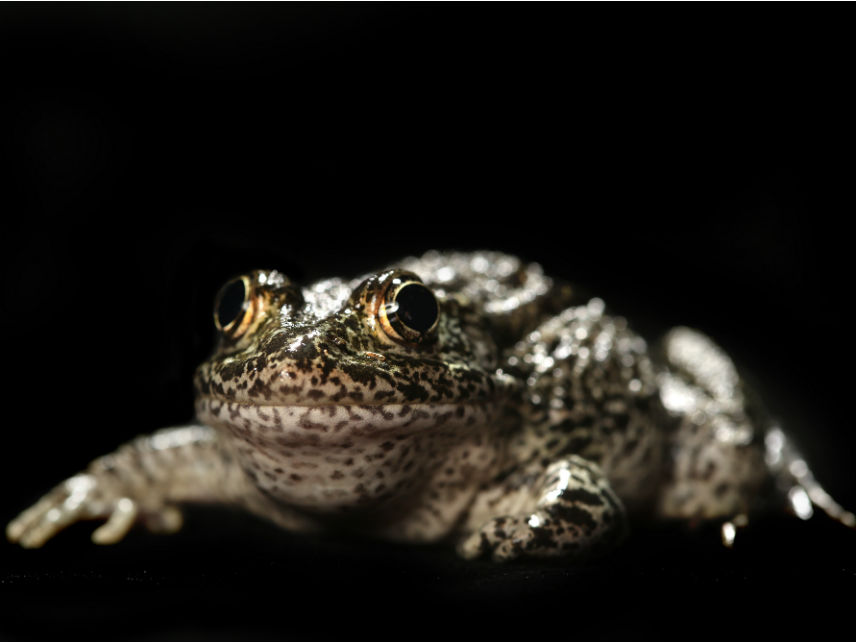Should Dried Up Tree Frog Sex Ponds Limit Property Rights?
The Supreme Court will rule on whether the Endangered Species Act has failed wildlife and private property owners alike.

The Supreme Court hears the first case of its new session tomorrow. The subject of Weyerhaeuser Company v. U.S. Fish and Wildlife Service is a shy, endangered frog, known among biologists for a call said to resemble an old man snoring.
Only about 150 dusky gopher frogs survive in the wild, and all of them are in southern Mississippi. That didn't stop the Fish and Wildlife Service from designating about 1,500 acres of private property in St. Tammany Parish, Louisiana, as critical habitat for the species in 2012. The designated acreage lies within the frog's historical range, but it's now part of dense commercial timber plantation that is nothing like the open-canopied habitat the amphibian needs.
The yearslong legal dispute over the frog demonstrates how the Endangered Species Act has failed wildlife and private property owners alike. The statute may have been written with good intentions, but it often punishes landowners in ways that have nothing to do with recovering species. The act makes enemies out of the private landowners who provide the majority of habitat for imperiled species.
The government's critical habitat designation in St. Tammany Parish hinges on five seasonal ponds that are—or, more exactly, were once—crucial for the dusky gopher frog's breeding cycle. The frog lays its eggs in shallow ponds that dry up completely in the summer, making it impossible for predatory fish to survive in them.
The Fish and Wildlife Service decided that these five ponds, which are part of much larger tract of timber leased by Weyerhaeuser and owned by New Orleans resident Edward Poitevent and his family, qualified the area as "essential" for conserving the species under the Endangered Species Act. Still, the agency admitted that "the surrounding uplands are poor-quality terrestrial habitat" for the species.
Even if the Supreme Court backs the feds, it's unclear how the agency's designation could actually help the frog. The property owners can still use the land as a timber plantation, and the government can't force a private citizen to actively engage in species recovery, let alone expend the money and effort it would require in this case to remake the landscape to support the frog.
"They don't care," Poitevent says. "Their job is to find a habitat. The consequences are not their problem."
According to the government's own analysis, the consequences could be as much as $34 million. That's the estimated value of the 1,544 acres, which lie north of Lake Pontchartrain in what has been described as "the boomingest corner of the state." Due to the area's potential, it was rezoned for development a few years ago.
The Endangered Species Act makes it illegal to harm not only an endangered species but also its habitat. This produces perverted incentives. Consider the case of the red-cockaded woodpecker, which has been listed as endangered throughout much of the U.S. South for decades. Landowners in North and South Carolina now harvest timber early to make sure their land never contains the old-growth pines that are prime habitat for the bird. This "preemptive habitat destruction" limits the woodpecker's prospects but ensures that property owners avoid the regulations that an endangered species might bring.
That's not exactly what the act's architects had in mind when they passed the law. The Berkeley law professor Holly Doremus has noted that discussion of the act was mainly about "charismatic species like grizzly bears, bald eagles, and timber wolves," and that "overhunting" was cited as a much greater concern than habitat destruction. Relatedly, attorney Shannon Peterson has argued that "no one in Congress contemplated that the prohibition against taking a listed species might lead to the regulation of land use activities on private property," adding that legislators "also failed to make the connection between habitat degradation and the taking of a species."
Maybe the act's modern shortcomings can be explained as a massive dereliction of duty on the part of the 93rd Congress. And given the law's broad powers to restrict land uses on private lands, many interest groups have emerged that fight hard to preserve its authority. But the fact remains that the act doesn't functionally resemble what its crafters intended, and that it can punish private landowners in ways that are not at all related to conservation.
Poitevent says that the government has in effect decided his land should be "potential backup" habitat for the frog. But your backyard could theoretically serve the same purpose. "You're not gonna spend enough money to turn it into frog habitat," he says. "So how does this benefit the frog? It doesn't, and it won't. Yet all they tell you is they need our land to save the frog."
